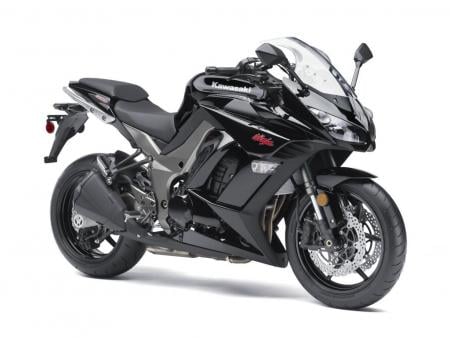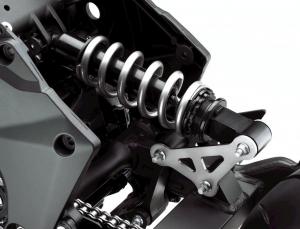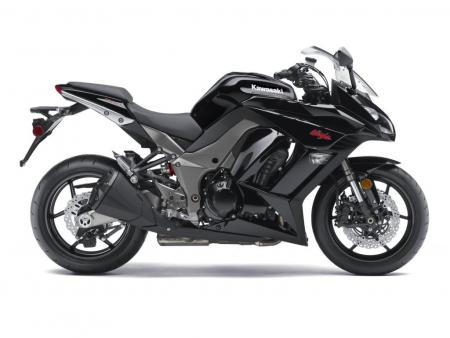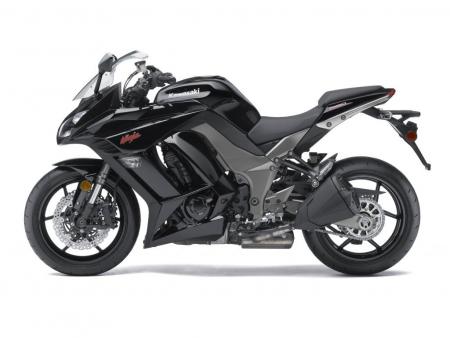 |
| Top 2013 Kawasaki Ninja 1000 Preview |
stroke is 77.0mm X 56.0mm, compared to the supersport’s 76.0mm X 55.0mm.
Back in black, Kawasaki’s latest Ninja 1000 is essentially a fully-faired Z1000. |
Coupled with less aggressive cam profiles, and lacking the ZX’s titanium intake and exhaust valves, the Ninja1000 will redline at 11,000 rpm instead of the ZX’s 13,000 rpm.
The 1043cc powerplant will deliver more torque lower in the powerband, at the expense of ultimate horsepower, while still able to rapidly scream through the rev range until it slams into its soft rev limiter.
When we dyno’d the 2010 Z1000 engine – which on paper is identical – it returned 123.4 hp at 10,250 rpm, and 74.8 ft-lbs torque at 7750 rpm at the wheel. In contrast, the 2010 ZX-10 made 153.2 hp at 12,300 rpm, and 71.6 ft lbs of torque at 9000 rpm.
We’ve enjoyed the 481-lb revised Z1000 since it was introduced, and expect the 503-lb Ninja 1000 will be a similarly potent roadburner. Part of the weight increase consists of about 6 lbs from one extra gallon of fuel. The Ninja 1000 carries 5.0 gallons, compared to the Zed’s 4.0 gallons.
Upright riding position, less rear-set rubber-topped pegs notwithstanding, this will be one potent machine. Just because the ZX-10 ten-tenths track machine is faster and sharper, on the street, there will be not much discernable performance difference for most riders. |
Holding it all together is an aluminum perimeter frame with tricks learned from the Z1000 and ZX-10. Wheelbase is 56.9 inches, compared to 56.7 inches for the Z1000, and 55.7 inches for the ZX-10 track weapon.
 |
| Top 2013 Kawasaki Ninja 1000 Preview |
Basic but effective, this horizontally-mounted shock will be able to better avoid heated breeze from the big mill in front of it.
An inverted 41mm cartridge fork with stepless compression and rebound damping, adjustable spring preload and 4.7 inches of travel provides 24.5 degrees of rake, and trail is ever-so-slightly longer at 4.0 inches compared to the Z1000’s 4.1 inches trail. In back, a horizontally mounted back-link monoshock, also straight from the Z, is said to help with mass centralization and resist overheating. It is gas/oil damped and the spring preload and rebound damping are adjustable. Brakes, too, are lifted from the Z1000. In front are twin 300mm petal-style discs with grip applied via four-piston radially mounted calipers. A matching 250mm rear rotor is clamped by a single piston caliper. Tires sizes will be 190/50-17 rear, and 120/70-17 front. They may be Dunlop Sportmaxes like the Z1000 has, or equivalent.
While it is essentially a Z1000 at heart, in the visuals department, its Ninja moniker comes to the fore with looks that are raceresque and aggressive. The blacked-out treatment coupled with black paint as shown is sure to catch the eye on the boulevard.
Instead of the Z1000’s tubular handlebar, the Ninja 1000 is fitted with clip-ons mounted high above the upper triple clamp. This allows the necessary clearance at full lock for the new fairing and provides a comfortably upright rider stance. Having ridden both the ZX-10R and Z1000 extensively, for the sake of riders over six-feet tall, we hope the seat distance aft-wards is less like the Z1000 and more like the ZX-10R, which is generous enough for long-legged riders.
Note three-way adjustable windscreen to raise to suitable height for a variety of torso lengths. Catalyzed exhaust meets stringent emissions regs without overly choking down the engine. |



No comments:
Post a Comment